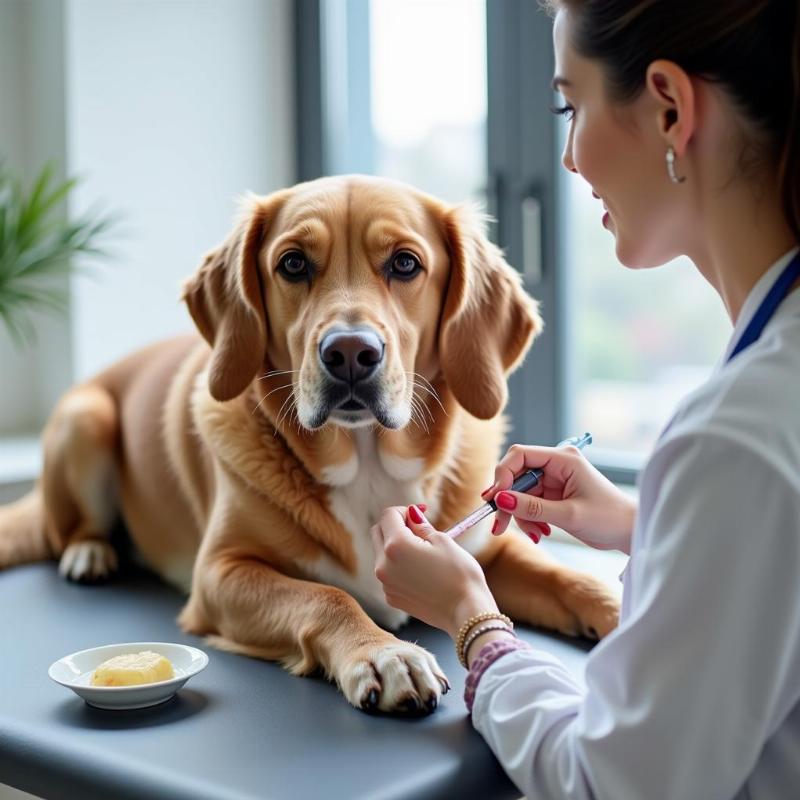Post-prandial bile acids testing is a valuable tool in diagnosing liver dysfunction in dogs. But getting accurate results relies heavily on proper timing. Knowing exactly how long after eating to perform the post-prandial bile acids dog test can be the difference between a clear diagnosis and continued uncertainty. This article will guide you through the specifics of timing this important test and help you understand its significance in your dog’s healthcare.
Understanding the Post-Prandial Bile Acids Test
The post-prandial bile acids test measures the concentration of bile acids in your dog’s bloodstream after eating. Bile acids aid in digestion and are normally reabsorbed by the liver. Elevated levels after a meal can signal liver issues, portosystemic shunts, or other metabolic concerns.
Ideal Timing for the Post-Prandial Bile Acids Test: Two Hours
The generally accepted ideal time to draw blood for a post-prandial bile acids test is two hours after your dog finishes eating. This timeframe allows sufficient time for the bile acids to be absorbed and processed by the liver. While some veterinarians may use a one-hour or even a four-hour window, the two-hour mark is considered the gold standard for most accurate results.
 Dog Getting Blood Drawn Two Hours After Eating
Dog Getting Blood Drawn Two Hours After Eating
Pre-Test Preparation and Procedure
To prepare your dog for the test, your veterinarian will likely recommend fasting for 12 hours prior to the test meal. This ensures that baseline bile acid levels are low. The meal itself should be a standardized, high-fat meal provided by your vet or follow their specific instructions regarding feeding your dog’s normal food. Avoid giving treats or any other food outside of the prescribed meal. After your dog eats, note the time and return to the veterinarian precisely two hours later for the blood draw. Another blood sample is taken before the meal as a baseline.
Why Two Hours is Key: Bile Acid Metabolism Explained
The two-hour mark captures the peak bile acid concentration in the bloodstream after absorption from the intestines and processing by the liver. Testing too early might not reflect the liver’s full capacity to reabsorb bile acids, while testing too late might miss the peak levels, leading to a less accurate assessment of liver function.
Interpreting the Results and What They Mean
Your veterinarian will compare the pre- and post-prandial bile acid levels to determine if they fall within the normal range. Elevated post-prandial bile acids suggest a problem with the liver’s ability to process and reabsorb these acids, possibly indicating liver disease, a shunt, or other metabolic disorders.
What if My Dog Vomits or Refuses to Eat?
If your dog vomits after the test meal or refuses to eat the provided food, inform your veterinarian immediately. They may need to reschedule the test or explore alternative diagnostic options. “Consistency is crucial,” says Dr. Emily Carter, DVM, a board-certified veterinary internal medicine specialist. “If the dog doesn’t eat the entire meal, the results can be skewed.”
Conclusion
Timing is everything when it comes to the post-prandial bile acids test. Adhering to the two-hour window after eating allows for the most accurate reflection of your dog’s liver function. This test, combined with other diagnostic tools, helps veterinarians pinpoint potential liver problems and guide appropriate treatment plans to ensure your furry friend’s long-term health. Remember to consult your veterinarian if you have any questions or concerns about your dog’s liver health.
FAQ
-
What are bile acids? Bile acids are produced by the liver and aid in digestion.
-
Why is the post-prandial bile acids test important? It helps diagnose liver dysfunction and other metabolic conditions.
-
Can I give my dog treats before the post-prandial bile acids test? No, your dog should only eat the prescribed test meal.
-
What happens if my dog’s bile acids are elevated? Your vet will likely recommend further testing to determine the underlying cause.
-
How long does the post-prandial bile acids test take? The blood draws themselves are quick, but the entire process, including fasting and the two-hour wait, takes several hours.
-
Is the post-prandial bile acids test painful for dogs? It involves a simple blood draw, which can be slightly uncomfortable but is generally well-tolerated.
-
What is a portosystemic shunt? A portosystemic shunt is an abnormal blood vessel that bypasses the liver, preventing it from filtering toxins effectively.
Beautdogs.us: Your Trusted Source for Dog Care
Beautdogs.us is your one-stop resource for expert advice on dog breeds, care, and lifestyle. We provide comprehensive, up-to-date information for both new and experienced dog owners. Our team of experts is passionate about helping you provide the best possible care for your canine companion. From breed-specific guides to the latest veterinary practices, Beautdogs.us has you covered. For more personalized guidance, contact us at [email protected] or call +1 501-555-7529.